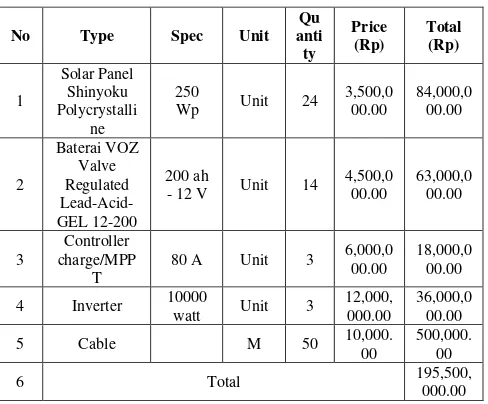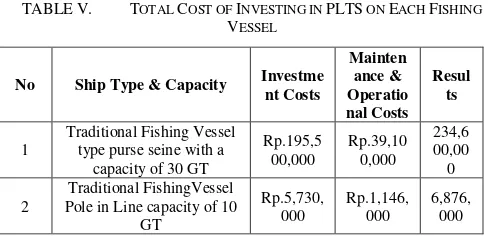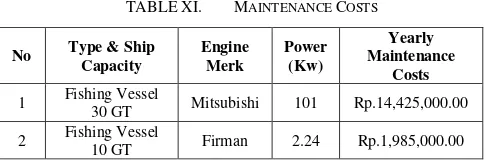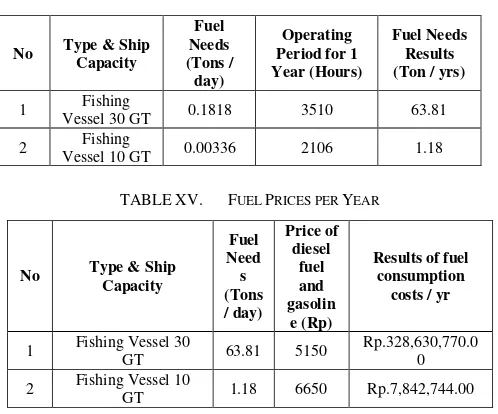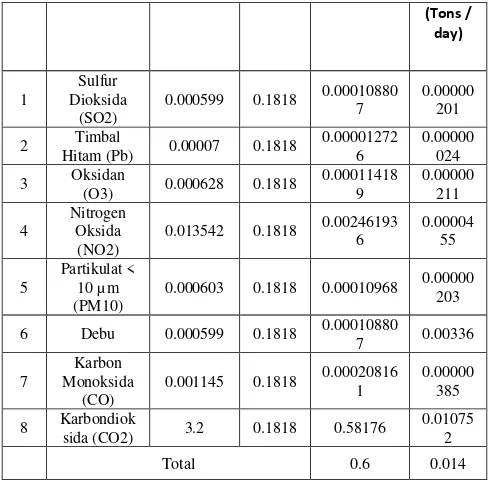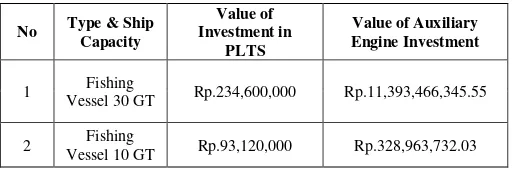Economic Calculation and Gas Emissions from Solar
Energy Utilization on Fishing Vessels 10 and 30 GT
in the South Coast of Java Island
Arif Fadillah[1], Shanty Manullang[2], Alfath Nst[3], Rizky Irvana[4]
1,2,3,4Department of Naval Architecs, Faculty of Ocean Engineering, Darma Persada University
Jl. Taman Malaka Selatan, Jakarta 13450 Indonesia E-mail: [email protected]
Abstract—Today, the world is getting worse cause the energy crisis. One of the solution to overcome the energy crisis is by reducing dependence on fossil energy sources by utilizing alternative energy sources. One of the energy is solar energy. In Indonesia, efforts to utilize solar energy have several advantages which are energy is available in large quantities. Solar energy in Indonesia has an intensity between 0.6 - 0.7 kW / m2, and energy is obtained for free. The study was conducted on the southern coast of Java Island which is located at Ujung Kulon and Palabuhan Ratu. The research method uses an experimental set up where primary data is obtained from the directly into filed. At the research located in Ujung Kulon using the object of a 30 GT fishing vessel research had the potential of laying solar panels as many as 24 pieces with a total investment cost of 20 years amounting to Rp.234,600,000 and total investment for ship auxiliary engines of Rp.11,393,466,345.55. For research at Pelabuhan Ratu using the research object of 10 GT capacity fishing vessel had the potential of laying solar panels as many as 20 pieces with a total investment cost of 20 years amounting to Rp.93,120,000 and total investment for ship auxiliary engines of Rp. 328,963,732.03. The value of long-term investment for 20 years shows that the value of PLTS investment is more profiTable than the value of investment in the auxiliary engine. The use of PLTS is very environmentally friendly .It does not produce any exhaust emissions, while the total level of exhaust emissions in auxiliary engines for 1 year on a 30 GT fishing vessel is 2052,944 tons and on a fishing vessel, 10 GT capacity is 29,837 tons.
Keywords—solar energy; solar panel; invesment in PLTS; gas emission; fishing vessel
I. INTRODUCTION
Energy is a major need throughout human history. In Indonesia Energy from fossils is the main choice for use. Indonesia's very high population growth cannot be balanced with nature, as a result, the depletion of petroleum reserves that produce energy. One effort to explore energy is to reduce dependence on fossil energy by utilizing alternative energy.Solar energy is one of the renewable energy sources that can answer alternative energy needs. The geographical conditions that Indonesia has as an archipelago that has a
long coastline and a vast ocean are more value for the use of solar energy.
Solar energy is one of the energies that are being actively developed at this time by the Indonesian government because as a tropical country, Indonesia has considerable solar energy potential. Based on solar irradiation data collected from 18 locations in Indonesia, solar radiation in Indonesia can be classified as follows: for western and eastern Indonesia with irradiation distribution in the Western Region of Indonesia (KBI) around 4.5 kWh / m 2 / day with monthly variations of around 10%; and in Eastern Indonesia (KTI) around 5.1 kWh / m 2 / day with a monthly variation of around 9%. Thus, Indonesia's average sunshine potential is around 4.8 kWh / m 2 / day with a monthly variation of around 9%.
Solar energy is a renewable energy source that can answer alternative energy needs.Ujung Kulon and Pelabuhan Ratu are one of the beaches located in the south of the island of Java. Many of the communities around the coast work as fishermen. Traditional fishing communities generally use diesel for vessel or boat engines, as well as kerosene for petromax lamp fuel. The problem of the revocation of kerosene subsidies will make a big problem for fishermen in Indonesia, because all their activities use petroleum.
Solar energy in Indonesia has an intensity between 0.6 - 0.7 kW / m2 (Manan, 2009). For Indonesia, the use of solar energy has several advantages, which are, energy is available in large quantities, and Indonesia is a tropical region where the average sunshine is 6 hours a day with very favorable weather, and the energy is obtained by free. The consumption of fuel oil in the shipping sector is quite large, especially as a source of electricity and fuel to move ships. The high price of fuel does not at all benefit the shipping industry and fishermen as motorized vessel users, so that fuel oil is a consideration for the use of electricity in ships as well as fuel to drive the ship's engines.Using solar panels as alternative energy will be very beneficial for fishermen because in terms of maintenance, the economy
and the impact on the environment of the use of solar power plants are very good. Therefore, this research will analyze the economic comparison between the use of auxiliary engines and PLTS.
With the above problems, it is necessary to conduct a study on the use of solar panels for the electricity needs of the fishing vessel. There needs to be a study on the cost of using solar panels on fishing vessels for the efficiency of solar costs for auxiliary engines, which are currently getting higher. The study was conducted by observing the fields directly, namely Palabuhanratu, Sukabumi and Ujung Kulon, Banten. The results show that the use of solar panels get a profiTable investment although the initial cost is very high. Using a solar energy with solar panel does not emit gas at all.
The use of fossil fuels is one of the causes of global warming and acid rain due to gas emissions produced and discharged into the environment. With the increasingly widespread environmental issues, especially in the field of maritime, the Marine Environment Protection Committee (MEPC) as one of the units in the International Maritime Organization (IMO) has revised Annex VI MARPOL to reduce levels of sulfur oxide (SOx), NOx, and CO2 emissions in ship gradually. The Annex VI MARPOL revision was carried out in order to succeed the IMO TIER III regulation. For all ships that will enter the territorial waters of a country that has ratified Annex VI MARPOL, it is required to meet the standards in accordance with these regulations. Therefore, at present various researches have been carried out to reduce exhaust emissions from ships, one of which is the use of a Solar Panel system as an alternative power that can be applied on board, especially on fishing vessels.
II. METHODOLOGY
The research method used in this study is an experimental and analysis method, which is to test and analyze energy requirements by utilizing solar energy as an alternative power on fishing vessels. In this study, technical analysis and economic value were carried out to design a system for the use of alternative power, namely solar power on fishing vessels.
A. Economic Calculation
1. Calculation of Investment Costs for PLTS and Auxiliary Engines
Based on secondary data from PLTS and auxiliary engines that already exist from the survey results in the field. Investment costs for PLTS are like the main components for making PLTS in fishing vessels such as solar panels, inverters, MPPT Solar charge controllers, batteries and cables along with maintenance and operational costs for 1 year to 20 years. Investment costs for auxiliary engines such as the price ofauxiliary engines and maintenance costs and their operations for 1 year to 20 years.
2. Economic Analysis of PLTS on Each Fishing Vessel. Analysis of ROI (Return On Investment) calculations is carried out based on the provisions of the Minister of Energy and Mineral Resources Regulation No. 17 of 2013 concerning the purchase of electricity by PLN from Photovoltaic Solar Power Plants, which states that the purchase of electricity from PLTS will be set at US $ 25 cents / kWh ( Twenty-five cents United States dollars per kilowatt hour).
Assumption :
1 US $ = Rp. 14,432 (August 2018) Then:
0.25 US $ = Rp.3608 (August, 2018)
Then the income generated per year from the PLTS on each ship is:
Rp.3608 x Total power produced by PLTS per year
3. Investment Return Time (Payback Period)
Payback Period = Total Investment / Net cash flow (1)
The shorter the payback period from the period required by the company, the investment project will be better and more accepTable.
4. Calculation of Net Present Value (NPV) NPV = Rt / Present Wort Factor (2) NPV = Rt / (1 + i)t(3)
Where:
NPV = Net Present Value Rt = cash inflows i = Interest Rate t = Time of Cash Flow
5. Exhaust Emission Estimates
To find exhaust emissions, each stage can be used as follows:
Ei (upstream): t x k x d (4) Ei (downstream): t x k x d (5) Ei (trip): t x k x d (6) Where :
t: time
k: fuel consumption d: engine power
Whereas to find the total emissions from pollutants are as follows:
Ei (Total) = Ei (upstream) + Ei (downstream) + Ei (trip) (7)
III. RESULTS AND DISCUSSIONS
A. Calculate the estimated investment cost of PLTS on a fishing vessel.
PLTS energy costs differ from the energy costs for conventional plants. This is because PLTS energy costs are influenced by high initial investment costs with low maintenance and operational costs. The initial investment costs for PLTS that will be developed on fishing vessels include costs such as costs for PLTS components and maintenance and operational costs. The cost for this PLTS component consists of costs for purchasing major
components such as solar panels, inverters, cables, and batteries.
TABLE I. ESTIMATION OF THE INVESTMENT COST OF PLTSEVERY COMPONENT OF A 30GT CAPACITY FISHING VESSEL
No Type Spec Unit
TABLE II. ESTIMATION OF THE INVESTMENT COST OF PLTSEVERY COMPONENT OF A 10GT CAPACITY FISHING VESSEL
No Item Spec Unit Qua cost of PLTS on each fishing vessel, for purse seine fishing vessels with a capacity of 30 GT the investment cost is Rp.195,500,000 and for fishing vessels, the capacity of 10 GT the investment cost is Rp. 5,730,000.
B. Calculate Estimation of PLTS Maintenance and Operational Costs
Maintenance and operational costs per year for PLTS, generally calculated at 1-2% of the total initial investment costs (Jais et al, 2012; S.G., Ramadhan et al, 2016). Based on these references, in this study, the percentage of maintenance and operational costs per year of PLTS which includes costs for solar panel cleaning, maintenance, and inspection of equipment and installation will be set at 1% of the total initial investment costs. The percentage determination of 1% is based on the fact that Indonesia only
experiences two seasons, namely the rainy and dry seasons so that the cleaning and maintenance costs of its solar panels are not as large as those in countries that experience four seasons in one year. In addition, this percentage determination is also based on the wage level of workers in Indonesia which is cheaper than the wage level of workers in developed countries. The amount of maintenance and operational costs (M) per year for PLTS that will be developed are as follows:
M = 1% x Investment Costs on Each Ship (8)
TABLE III. ESTIMATED MAINTENANCE AND OPERATIONAL COSTS
No Ship type & seine with a capacity
of 30 GT in Line capacity of
10 GT
Rp.5,730,000 1% Rp.57,3
00
In Table III is the result of calculation of estimated maintenance and operational costs of PLTS on each fishing vessel for a year, for purse seine fishing vessels with a capacity of 30 GT maintenance and operational costs amounting to Rp.1,955,000, and for fishing vessels the capacity of 10 GT is 57,300. If an estimated solar panel age reaches 20-25 years, the total maintenance and operational costs are assumed to be 20 years as follows:
TABLE IV. ESTIMATED MAINTENANCE AND OPERATIONAL COSTS FOR 20 YEARS
No Ship type & capacity
Maintenan Vessel type purse seine with a capacity of 30 GT Line capacity of 10 GT
Rp.57,300 20 Rp.1,14
6,000
In the Table IV above the result of the calculation of estimated maintenance costs and operation of solar power plants on each fishing vessel for 20 years, for purse seine fishing vessels with a capacity of 30 GT the maintenance and operational costs are Rp.39,100,000 and for fishing vessel capacity of 10 GT is Rp. 1.146,000.
C. Total investment of PLTS on each fishing vessel
The total investment of PLTS is the total estimated cost for PLTS on each vessel, covering the total investment costs and added maintenance costs along with the PLTS operation for 20 years shown in Table V.
TABLE V. TOTAL COST OF INVESTING IN PLTS ON EACH FISHING
VESSEL
No Ship Type & Capacity Investment Costs
Mainten type purse seine with a
capacity of 30 GT Pole in Line capacity of 10
GT
In the Table above is the result of the calculation of the total investment cost of PLTS on each fishing vessel, for traditional fishing vessels of the purse seine type with a capacity of 30 GT the total investment cost of the PLTS is Rp.234,600,000 and for fishing vessels the capacity of 10 GT the total investment cost of the PLTS for the pole in line fishing vessel is Rp.6,876,000
D. Economic Analysis of PLTS on Each Fishing Vessel.
In Table VI, the results of the analysis of ROI and for fishing vessels with a capacity of 10 GT the results of the cash calculation were Rp. 12,958,493 per year.
TABLE VI. CALCULATION OF RETURN ON INVESTMENT (ROI)
No Ship Type Price/kWh
F. Net Present Value
The NPV calculation is made with a projected calculation of revenues and costs that occurred for 20 years (based on the use of interest rates of 11% every year).
TABLE IX. NPVVALUE OF PLTS IN FISHING VESSEL 10GT FOR 20
In the Table VIII & IX above shows that the NPV value for each fishing vessel is Positive. So it can be concluded, PLTS investment in each fishing vessel can be accepted or run. When compared to the age of solar panels which are estimated to reach 20 years, then from the ROI analysis obtained the design of solar power plants is very beneficial for shipowners and fishermen in Indonesia, especially in the Ujung Kulon and Pelabuhan Ratu areas which are the locations of research.
G. Estimated Investment Cost of Auxiliary Engines in Each Fishing Vessel.
Calculating estimated investment costs in auxiliary engines on each fishing vessel is seen based on the auxiliary engine power specifications on each vessel, which includes
investment in auxiliary engine prices and operating costs for 20 years that show on Tbale 10 below.
TABLE X. THE PRICE OF AUXILIARY ENGINES IN EACH SHIP
H. Estimated Maintenance and Operational Costs of Auxiliary Engines
Calculating estimated maintenance and operational costs of auxiliary engine for each fishing vessel includes the cost of ship engine maintenance and fuel costs for 1-20
30 GT Mitsubishi 101 Rp.14,425,000.00
2 Fishing Vessel 30 GT has a maintenance cost of Rp. 14,425,000.00 per year and a 10 GT pole in line capacity fishing vessel are as large as Rp. 1,985,000.00. To get a 20-year maintenance and operational projection it is assumed to use the average inflation rate in Indonesia for the last 3 years from the 2016-2018 Bank Indonesia INFLATION (Consumer Price Index) Report of 3.7% assumed to be the highest value of 5%.
In the Table XII above is the total cost of maintenance and operation of auxiliary engines on each fishing vessel. For fishing vessels Purse Seine Traditional 30 GT has a total cost of Rp.476,976,387.93, and for traditional pole in line fishing vessels with a capacity of 10 GT has a total cost of Rp.65,635,918.89.
TABLE XII. MAINTENANCE COSTS FOR A 30&10GT FISHING VESSEL FOR 20 YEARS
No Maintenance and
Investment costs 30 GT
Maintenance and Investment costs 10 GT
1 Rp.14,425,000.00 Rp.1,985,000.00
2 Rp.15,146,250.00 Rp.2,084,250.00
3 Rp.15,903,562.50 Rp.2,188,462.50
4 Rp.16,698,740.63 Rp.2,297,885.63
5 Rp.17,533,677.66 Rp.2,412,779.91
6 Rp.18,410,361.54 Rp.2,533,418.90
7 Rp.19,330,879.62 Rp.2,660,089.85
8 Rp.20,297,423.60 Rp.2,793,094.34
9 Rp.21,312,294.78 Rp.2,932,749.06
10 Rp.22,377,909.52 Rp.3,079,386.51
11 Rp.23,496,804.99 Rp.3,233,355.83
12 Rp.24,671,645.24 Rp.3,395,023.63
13 Rp.25,905,227.50 Rp.3,564,774.81
14 Rp.27,200,488.88 Rp.3,743,013.55
15 Rp.28,560,513.32 Rp.3,930,164.22
16 Rp.29,988,538.99 Rp.4,126,672.44
17 Rp.31,487,965.94 Rp.4,333,006.06
18 Rp.33,062,364.23 Rp.4,549,656.36
19 Rp.34,715,482.45 Rp.4,777,139.18
20 Rp.36,451,256.57 Rp.5,015,996.14
TOT
AL Rp.476,976,387.93 Rp.65,635,918.89
TABLE XIII. FUEL REQUIREMENTS FOR EACH AUXILIARY ENGINE
No Type & Ship cost for each fishing vessel for 20 years that show on Table 16, it is assumed to use an average fuel increase every year by 5%. The fuel price is got by Table XII, XIV, & XV.
1 Rp.328,630,770.00 Rp.7,842,744.00
2 Rp.345,062,308.50 Rp.8,234,881.20
3 Rp.362,315,423.93 Rp.8,646,625.26
4 Rp.380,431,195.12 Rp.9,078,956.52
5 Rp.399,452,754.88 Rp.9,532,904.35
6 Rp.419,425,392.62 Rp.10,009,549.57
7 Rp.440,396,662.25 Rp.10,510,027.04
8 Rp.462,416,495.36 Rp.11,035,528.40
9 Rp.485,537,320.13 Rp.11,587,304.82
10 Rp.509,814,186.14 Rp.12,166,670.06
11 Rp.535,304,895.45 Rp.12,775,003.56
12 Rp.562,070,140.22 Rp.13,413,753.74
13 Rp.590,173,647.23 Rp.14,084,441.43
14 Rp.619,682,329.59 Rp.14,788,663.50
15 Rp.650,666,446.07 Rp.15,528,096.67
16 Rp.683,199,768.37 Rp.16,304,501.51
17 Rp.717,359,756.79 Rp.17,119,726.58
18 Rp.753,227,744.63 Rp.17,975,712.91
19 Rp.790,889,131.86 Rp.18,874,498.56
20 Rp.830,433,588.46 Rp.19,818,223.48
TOTA
L Rp.10,866,489,957.62 Rp.259,327,813.14
TABLE XVII. TOTAL FUEL COSTS FOR FISHING VESSELS FOR 20YEARS
No Type & Ship Capacity Total Cost of Fuel Consumption
1 Fishing Vessel 30 GT Rp.10,866,489,957.62
2 Fishing Vessel 10 GT Rp.259,327,813.14
In Table XVII is the result of calculating the total cost of fuel for fishing vessels for 20 years. For traditional fishing vessels, the purse seine type with a capacity of 30 GT has a total cost of Rp. 10,866,489,957. For 10 GT is Rp. 259,327,813. The total of the maintenance and operational costs of auxiliary engine for 20 years is shown in the following Table:
Total Maintenance and Operational = Total Cost of Fuel Consumption + Maintenance Engine and Operational Costs for 20 years that show in Table XVIII.
TABLE XVIII. TOTAL MAINTENANCE & OPERATION OF FISHING VESSELS FOR 20 YEARS
I. Total investment of Auxiliary Engines in Each Fishing Vessel
The total investment of Auxiliary Engine is the total estimated cost for auxiliary engines in each vessel, covering the total investment costs and added maintenance costs along with the operation of the auxiliary engine for 20 years shown in Table1 & 2.
Total Investment = Investment Cost + Maintenance and
In Table XIX is the result of the calculation of the total investment costs of Auxiliary Engines/generators on each fishing vessel, for traditional fishing vessels of purse seine type with a capacity of 30 GT total investment costs of Rp. 11,393,466,345.55, and for fishing vessels the capacity of 10 GT is Rp. 328,963,732.03.
J. Auxillary Emissions On Every Fish Ship
Standards for motor vehicle transport emissions can be seen in the Table20 below.
TABLE XX. EXHAUST EMISSION STANDARDS
No Air Quality
Parameters
Elemen t
Emission Factor (gr / liter)
TABLE XXI. FUEL CONSUMPTION FOR EACH FISHING VESSEL PER DAY
No from Table XXIII. Power from the vessel data.
TABLE XXII. GAS EMISSIONS AUXILIARY ENGINE OF FISHING VESSEL
0.000599 0.1818 0.00010880
7
0.013542 0.1818 0.00246193
6
0.000603 0.1818 0.00010968 0.00000
203
0.001145 0.1818 0.00020816
1
based on auxiliary engine exhaust emissions per day and multiplied by the operating duration of auxiliary engines for one year, the total results of these calculations are 2052,944 tons/year and for 10 Gt is 29,84
Highest Exhaust Gas Emissions are Nitrogen Oxide (NO2), air pollution by NO2 gas can cause Peroxy Acetyl Nitrates which is abbreviated as PAN. Peroxide Acetyl Nitrates causes irritation to the eyes which causes the eyes to feel sore and runny. Carbon dioxide (CO2), air pollution by carbon dioxide will perforate the ozone layer, the greenhouse effect, the sun's light & heat entering the earth cannot be released into space cosmically, increasing the earth's temperature globally by several degrees, melting polar ice so as to increase the water surface the sea. Carbon monoxide, the effect caused by excessive carbon monoxide is inhibiting the supply of oxygen to the body, disrupting nerve function, disrupting the function of the heart, if in large amounts it will cause poisoning, weakness, dizziness, and unconsciousness.
K. Economic And Emission Analysis Of PLST With Auxillary Engines
1. Comparison of Investment Value of PLTS with Auxiliary Engines
TABLE XXIV. COMPARISON OF INITIAL INVESTMENT VALUE FOR A YEAR
No Type & Ship Capacity
Value of Investment in
PLTS
Value of Auxiliary Engine Investment
1 Fishing Vessel 30 GT Rp.209,575,000.00 Rp.343,055,770.00
2 Fishing Vessel 10 GT
Rp.63,125,000.0
0 Rp.9,827,744.00
In the Table XXIV above is a comparison of the value of PLTS investment with the investment value of auxiliary engine on fishing vessels. It can be seen that the value of the initial investment for a year for PLTS is indeed very large except for the traditional purse seine fishing vessel with a capacity of 30 GT, because the auxiliary engines and maintenance costs are indeed very large to meet the huge electricity needs also on the ship. But the value of long-term investments for 20 years, PLTS is better than auxiliary engines. Shown in Table below.
TABLE XXV. COMPARISON OF INITIAL INVESTMENT VALUE FOR A 20 YEAR
No Type & Ship
Capacity
Value of Investment in
PLTS
Value of Auxiliary Engine Investment
1 Fishing
Vessel 30 GT Rp.234,600,000 Rp.11,393,466,345.55
2 Fishing
Vessel 10 GT Rp.93,120,000 Rp.328,963,732.03
Can be seen in Table XXV, The value of long-term investment for 20 years shows that the value of PLTS investment is more profiTable than the investment value of auxiliary engine. Factors that cause a very high increase in
the value of investment in auxiliary engine are the effects of fuel use and maintenance and operation of auxiliary engines that continue to increase every year while the PLTS does not use BBM at all and maintenance on the PLTS is relatively sTable.
2. Comparison of PLTS Exhaust Emissions with Auxiliary Engines
TABLE XXVI. COMPARISON OF EXHAUST GAS EMISSIONS FOR 1 YEAR
No Type & Ship Capacity
Exhaust PLTS Emission Gas Value
(Ton)
Flue Gas Emission Value
(Tons)
1 Fishing Vessel
30 GT 0 2,052,944
2 Fishing Vessel
10 GT 0 29,837
Based on Table XXVI, the value of exhaust gas in PLTS for 1 year is 0 tons or can be said to be nonexistent, while for exhaust gas emissions produced by auxiliary engines for 1 year with the highest value of 2052,944 tons produced by auxiliary engines diesel fuel owned by the traditional fishing vessel purse seine with a capacity of 30 GT. For auxiliary engines on a 10 GT pole in line traditional fishing vessel that has used gasoline, it still emits a considerable amount of exhaust gas, which is 29.84 tons per year. So it can be concluded that the analysis of exhaust emissions from the use of PLTS is very environmentally friendly because it does not emit exhaust emissions at all, it is very different from the use of auxiliary engines on ships with very high levels of exhaust emissions and can cause air pollution and damage to nature.
IV. CONCLUSION
From the results of the analysis conducted are as follows It can be concluded that the initial investment (capital) value for a year for PLTS is very large except for the traditional purse seine fishing vessel with a capacity of 30 GT, but the value of long-term investment over 20 years shows that the value of PLTS investment is more profiTable than the investment value of auxiliary engine on fishing vessels fish. For exhaust gas emissions, it can be concluded that the analysis of exhaust emissions from the use of PLTS is very environmentally friendly because it does not emit exhaust emissions at all, it is very different from the use of auxiliary engines on ships with very high levels of exhaust emissions and can cause air pollution and natural damage.
REFERENCES
[1] Darmoyo. 2007. Penstabil Fluktuasi Tegangan Charger Handphone Tenaga Surya [Skripsi]. Semarang : Teknik Elektro, Universitas Negeri Semarang.
[2] Dhear P. Putri et al, 2016. Perencanaan Sistem Pembangkit Listrik Hybrid (Sel Surya dan Diesel Generator) Pada Kapal Tanker. Surabaya : Institut Teknologi Sepuluh Nopember.
[3] Dinas Perikanan Pandeglang Banten, 2017 :
Dinasperikanan.pandeglangkab.co.id
[4] Direktorat Kapal Perikanan dan Alat Penangkapan Ikan. 2009. Alat Penangkapan Ikan. Jakarta. Hal. 61
[5] Fyson, J. 1985. Design of Small Fishing Vessels. England: Fishing News Book.Great Britain: B.H Newnes
[6] International Maritime Organization (IMO). 1983. International Confrence on Safety Fishing Vessels 1977. IMO. London. [7] Irvana Rizky, 2018. Analisa Seakiping & Pengaruh Karakteristik
Geometri Terhadap Stabilitas Kapal Ikan Ikan Multi Purpose, 10, 10, & 30 GT [Skripsi] Jakarta : Universitas Darma Persada.
[8] Iskandar, B.H dan Sri Pujiati. 1995. Keragaan Teknis Kapal Perikanan di Beberapa Wilayah Indonesia. Laporan Penelitian. Bogor: Institut Pertanian Bogor, Fakultas Perikanan, Program Studi Pemanfaatan Sumberdaya Perikanan.
[9] Jais Wan Agung et al, 2012. Perencanaan PLTS Untuk Wilayah Kabupaten Gowa Dusun Pakkulompo Provinsi Sul-Sel. Makasar : Politeknik Negri Ujung.
[10] Kok, H.G.M, Lonkhyusen, E.G.V and Nierich, F.A.C. 1983. Bangunan Kapal. Zundort. Netherland
[11] Laksanawati, V. 2006. Sistem Pengontrolan Suplai Energi Untuk Pendinginan Termoelektrik Dengan Menggunakan Sel Surya [Skripsi]. Departemen Teknik Pertanian. Fakultas Teknologi Pertanian. Institut Pertanian Bogor.
[12] Manan, S. 2009. Energi Matahari, Sumber Energi Alternatif Yang Effisien, Handal, Dan Ramah Lingkungan Di Indonesia [Karya Tulis]. Semarang : Program Diploma II Teknik Elektro, Universitas Diponegoro.
[13] Nomura, M and T. Yamazaki. 1977. Fishing Technique (1). Tokyo: Japan International Corporation Agency (JICA).
[14] Peraturan Mentri ESDM No.17 Tahun 2013 tentang pembelian listrik oleh PLN dari Pembangkit Listrik Tenaga Surya Fotovoltaik
[15] Pratama Putra 2016. Anlisa Angkutan Baturabara dengan Konsep Penggunaan Tongkang Kosong di Pelabuhan dengan Pemanfaatan Pasang surut sungai. Unsada Jakarta.
[16] Pusat Informasi Pelabuhan Perikanan : Pelabuhan perikanan
Nusantara Pelabuhan Ratu.
http://pipp.djpt.kkp.go.id/profil_pelabuhan/1174/informasi. Diakses 20 Juli 2018
[17] Pusat Pendidikan Kelautan dan Perikanan, 2012. Penangkapan Ikan dengan Purse Seine. Jakarta : Pusdik KKP.
[18] Reza Ahkmad, S. 2012. Percobaan Pendahuluan Pemanfaatan Energi Surya Sebagai Energi Alternatif Sistem Kelistrikan Lampu Navigasi Pada Kapal Penangkap Ikan. IPB. Bogor.
[19] Rosenblum, L. 1991. Photovoltaic Sistem Design. Solar Energy in Agriculture. Elsevier Science Publishing Company. New York, USA. [20] Rotib, W. 2001. Aplikasi Sel Surya Sebagai Sumber Energi
Alternatif; Dimensi Vol 4 No. 1 Juni 2001. www.istecs.org. [20 September 2007]
[21] Routledge, G. 2002. Lighting The Way To A Low-Energy Future. IEE Review Volume 48.
[22] S.G., Ramadhan, 2016. Perencanaan Pembangkit Listrik Tenaga Surya di Atap Gedung Harey Hartono Universitas Trisakti. Jakarta : Universitas Trisakti.
[23] Setianto, Indradi. 2007. Kapal Perikanan. UNDIP. Semarang. [24] Sumarna Zuhdi, 2016. Analisi Kelayakan Alternatif Investasi Kapal
Penangkap Ikan Kabupaten Rembang, 2016. [Skripsi] Surabaya : Institut Teknologi Sepuluh Nopember.
[25] Syahrul. 2006. LED, Light Emitting Diode: Teknologi Dan Perkembangannya. [Jurnal]. Bandung : Teknik Komputer, Universitas Komputer Indonesia.
Halaman ini sengaja dikosongkan
